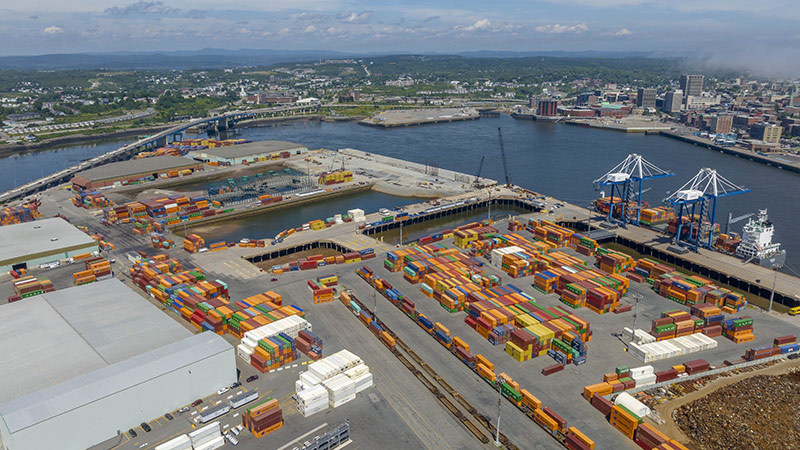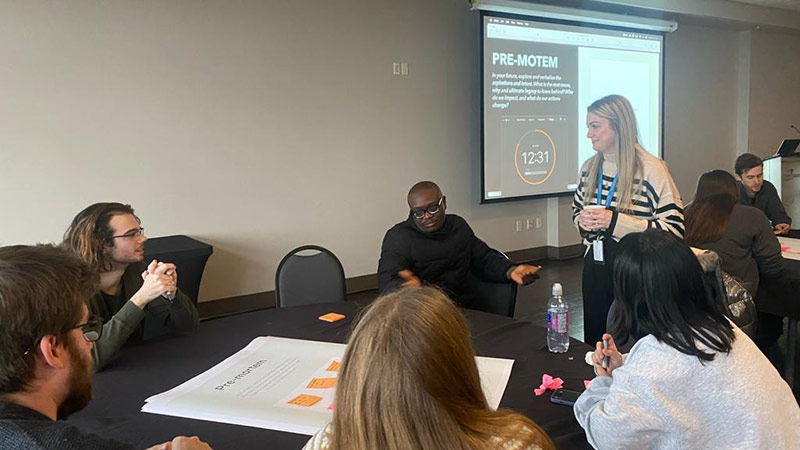A match made in heaven: UNB students and Port Saint John tackle decarbonization
Author: Tim Jaques
Posted on Apr 11, 2024
Category: UNB Saint John

An innovative experiential learning partnership between the faculty of business on the University of New Brunswick’s (UNB) Saint John campus and Port Saint John has allowed 150 students to propose solutions to environmental challenges faced by a real-world industry.
“The real goal of the experience was the idea of what could the future look like? How could you influence the future around decarbonization and sustainability?” said David Marshall, assistant teaching professor in the faculty of business.
Along with associate dean Greg Fleet, Marshall guided students through the process last fall semester as part of the Port Saint John Emergent Futures Decarbonization and Sustainability Initiative.
This project is funded in part by the Government of Canada’s Innovative Work-Integrated Learning (I-WIL) Initiative and the Co-operative Education and Work-Integrated Learning Canada’s (CEWIL Canada) iHUB, which promotes post-secondary work-integrated learning experiences.
“CEWIL Canada is pleased to support innovative WIL experiences for students at the University of New Brunswick, where students have been able to receive financial support and recognition for their WIL experience,” said Charlene Marion, director of WIL at CEWIL Canada.
“Funds such as these aim to eliminate barriers to WIL and increase access for all post-secondary students.”
Marshall described the project as “a match made in heaven.” Port Saint John is a critical player in the region's economic and environmental health, and the initiative provided a meaningful and substantial experience for the students, connecting them to a complex global issue in the local context.
Students came from both the undergraduate and MBA programs, and were enrolled in the courses How Business Works, Issues in Business and Society, and Design & Systems Thinking. This included students from the faculty of business, as well as from arts, computer science and health.
The project culminated with a complete tour of the Port’s facilities, where about 80 students engaged in a brainstorming session with Port employees.
“We used a unique, nine-step process imagining a series of potential and emergent futures. How do you look at the present and imagine a sustainable world?” asked Fleet.
An example step was a “pre-mortem,” analogous to writing your own obituary with achievements for which you would want to be remembered.
“They had limited time and had to work as a team. It was pretty fast-paced, but pretty active. Those nine exercises were about pushing them to think about possible futures relating to decarbonization and sustainability,” Fleet said.
The students also worked through standard business analysis tools, such as SWOT analysis (strengths, weaknesses, opportunities, and threats), PESTEL analysis (political, economic, socio-cultural, technological, legal, and ethical-environmental) and Risk Register.
All this work will be distilled into a report for the Port.
“The University of New Brunswick Saint John and Port Saint John have had a long-standing relationship, and this particular partnership was inspired by a post-secondary pitch competition that we had held in 2022 related to decarbonization,” said Jane Burchill, the decarbonization and environment manager for Port Saint John.
“It is one of the more complicated types of businesses with our connection to the federal government, our role as a landlord and the supply chain as a whole,” said Burchill.
She said that while “constraints and red tape” stand in the way of change, students’ “sky-is-the-limit attitude” enabled innovative thinking.
“For those who work closely on this topic or in the port industry in general, we sometimes may be too close to a project to be able to apply the same limitless thinking,” Burchill said.
The Port is already a leader in clean energy, and its cruise terminals, corporate offices and cargo terminals are powered entirely by 2,500 megawatt-hours of wind-generated energy from Saint John Energy and Natural Forces’ Burchill Wind Farm.
Port Saint John is working on decarbonization of the cargo and cruise ship sectors, offering a reduction in port tariffs to ships that meet certain air emission standards. It encourages cruise ships to share their in-berth data to reduce emissions.
The Port is also undergoing a greenhouse gas inventory and baseline report in accordance with the Greenhouse Gas Protocol Corporate Accounting and Reporting Standard through its membership with Green Economy New Brunswick.
Students suggested further initiatives, such as electrification of the Port’s vehicles and machinery, the use of solar panels or alternative fuels in some circumstances, and more attention to smaller details such as curbing the use of plastics and reducing overall waste following a decades-long action plan.

Establishing workable solutions to complex decarbonization challenges is not as easy as it may sometimes appear in a classroom.
Darren LeBlanc, a first-year business student at the time, said he realized much of the Port’s carbon footprint fell outside its control.
“Intuitively, it made sense, but it brought the complexity and interconnectedness of the decarbonization process to the forefront,” he said.
Allison Cooke, a fourth-year business student, said she learned cost, time and available resources become determining factors in finding solutions.
“We couldn’t just suggest the Port consider new alternative fuel methods, as we learned that a lot of the Port customers have not yet converted to being able to use alternative fuel methods themselves. Switching may result in the Port losing customers,” she said.
Nick Connor, a third-year health student, said the approach allowed for hands-on experience working with people who are directly involved in the issues.
“Learning about the concerns and issues, like public perception, and feasibility of altering or implementing business practices from Port Saint John was more valuable than just discussing how a business could do this in hypothetical situations.”
LeBlanc said the process made him realize that “having a list of solutions” is only part of the answer.
“The implementation of those solutions is much more complicated than it seems like it should be in a classroom setting, especially with respect to what was within the scope of the Port to actually change,” he said.
The grant allowed the program to pay students $700 each for their efforts.
Burchill said she values the ongoing relationship with the University of New Brunswick, and Marshall and Fleet foresee more projects with Port Saint John.
“Both Dave and I have good reason to believe that this is only the start of years of working together with the Port for our business students,” said Fleet.
UNB is a centre for experiential education connecting students with industry and the community, building a skilled, qualified workforce for tomorrow. This is the last in a series of stories about students deepening their learning outside the classroom, discovering their passions and making meaningful change in the world around them.
Other stories in the series:
- UNB education students embrace Indigenous wisdom
- Lucy Armstrong helps students eat better so they can focus on their studies
- $14-million Student Investment Fund celebrates 25 years of hands-on learning
Top photo: Courtesy Port Saint John
Inside photo: Business students from UNB worked with Port Saint John officials in a brainstorming session to produce proposed solutions for decarbonization and sustainability.
